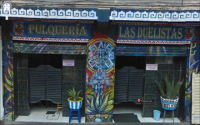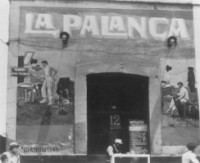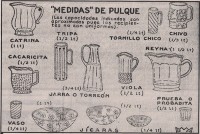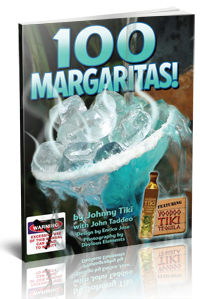This is part 4. For part 3, Click Here
 Today, most pulque is consumed in bars called “pulquerías”. At the beginning of the 20th century, there were more than 1,000 of these in Mexico City alone. By the early 20th century, pulquerías became socially accepted and some were places of great elegance. But whether for rich or poor, two features stood out among these establishments, odd or catchy names and murals decorating the walls. Names included (translated) “My Office,” “Memories of the Future,” “Drink and Go,” I’m Waiting for You Here at the Corner” and, across the street from the National Chamber of Deputies, “The Recreation Center of Those Across the Street.” Diego Rivera once said that one of the most important manifestations of Mexican painting was the murals that decorated the facades and interiors of pulquerías.
Today, most pulque is consumed in bars called “pulquerías”. At the beginning of the 20th century, there were more than 1,000 of these in Mexico City alone. By the early 20th century, pulquerías became socially accepted and some were places of great elegance. But whether for rich or poor, two features stood out among these establishments, odd or catchy names and murals decorating the walls. Names included (translated) “My Office,” “Memories of the Future,” “Drink and Go,” I’m Waiting for You Here at the Corner” and, across the street from the National Chamber of Deputies, “The Recreation Center of Those Across the Street.” Diego Rivera once said that one of the most important manifestations of Mexican painting was the murals that decorated the facades and interiors of pulquerías.
 One tradition maintained at all pulquerias at the beginning of the 20th century was to put sawdust on the floor. The tradition at that time was to begin a pulque-drinking session by spilling a little on the floor or ground as an offering to Mother Earth. Traditional pulquerías tend to be like clubs with closed membership, with casual visitors ignored or sometimes stared at. Frequent visits and large consumption of the drink tends to win acceptance. While some establishments may forbid women,[4] it is much more common for the establishment to provide a separate seating area for them. Intermingling of the sexes is not permitted. In the more rural areas of Hidalgo and Tlaxcala, where most pulque is made, the pulque is fresher and better. A vendor usually displays a white flag over the door when a fresh shipment has arrived.
One tradition maintained at all pulquerias at the beginning of the 20th century was to put sawdust on the floor. The tradition at that time was to begin a pulque-drinking session by spilling a little on the floor or ground as an offering to Mother Earth. Traditional pulquerías tend to be like clubs with closed membership, with casual visitors ignored or sometimes stared at. Frequent visits and large consumption of the drink tends to win acceptance. While some establishments may forbid women,[4] it is much more common for the establishment to provide a separate seating area for them. Intermingling of the sexes is not permitted. In the more rural areas of Hidalgo and Tlaxcala, where most pulque is made, the pulque is fresher and better. A vendor usually displays a white flag over the door when a fresh shipment has arrived.
 Traditionally, pulque is served from large barrels on ice, and served into glasses, using a “jicara”, which is a half of a calabash tree gourd. The bartender is called a “jicarero”. In a pulquería, the word “cruzado” means something like “bottoms up”. Traditional glassware for pulque circa 1950 on display at the Museo de Artes Populares, Mexico City. Drinking glasses have colorful names and can reflect a customer’s ability to drink pulque. Large two-liter glasses are called “macetas” (flower pots), one-liter glasses are called Cañones (cannons), half–liters are called Chivitos (little goats), quarter-liter glasses are Catrinas (dandy), and eighth-liter glasses are Tornillos (screws). Traditionally, these glasses are made from a greenish, hand blown glass. Pulque can be drunk straight from the barrel or can have a number of additives such as fruit or nuts mixed in. Pulque prepared this way is called “curado” or cured.
Traditionally, pulque is served from large barrels on ice, and served into glasses, using a “jicara”, which is a half of a calabash tree gourd. The bartender is called a “jicarero”. In a pulquería, the word “cruzado” means something like “bottoms up”. Traditional glassware for pulque circa 1950 on display at the Museo de Artes Populares, Mexico City. Drinking glasses have colorful names and can reflect a customer’s ability to drink pulque. Large two-liter glasses are called “macetas” (flower pots), one-liter glasses are called Cañones (cannons), half–liters are called Chivitos (little goats), quarter-liter glasses are Catrinas (dandy), and eighth-liter glasses are Tornillos (screws). Traditionally, these glasses are made from a greenish, hand blown glass. Pulque can be drunk straight from the barrel or can have a number of additives such as fruit or nuts mixed in. Pulque prepared this way is called “curado” or cured.
One of the limitations to pulque’s popularity has been the inability to store it for long periods or ship it far. Recently, pulque makers have found a way to preserve the beverage in cans. However, they admit that this does change the flavor. The hope is that with this innovation, pulque can regain its lost market in Mexico and even achieve success as an export item, like tequila.
The complex and delicate fermentation process of pulque had always limited the product’s distribution as it does not keep long and agitation during transport speeds degradation. Since pre-Hispanic times, its consumption has mostly been limited to the central highlands of Mexico.
The decline of pulque began in the first decade of the 20th century, when the Mexican Revolution caused a decline in its production. In the 1930s, the government of Lázaro Cárdenas campaigned against pulque, as part of an effort to reduce alcoholic consumption in general. But the most decisive factor to the decline of pulque has been the introduction of beer. Despite recent efforts, in the 20th century, pulque fell into decline, mostly because of competition from beer, which became more prevalent with the arrival of European immigrants. There are some efforts to revive the drink’s popularity through tourism.
Pulque’s popularity is low and continues to fall. Twenty years ago, about twenty trucks would come every three days to Xochimilco in southern Mexico City to deliver pulque, but now the number is down to one or two. Only five pulquerias remain in this district, where there used to be eighteen. It is similar in most other parts of Mexico as well. Those pulquerias that are left are very small establishments, selling a product made by small producers.
Will pulque rise again? It is currently being offered in the United States by Boulder Imports, selling the brand “Nectar del Razo”. The original market was Mexican-American men, but the company reports that the product is having success as a health food, sought out by athletes and body builders.



